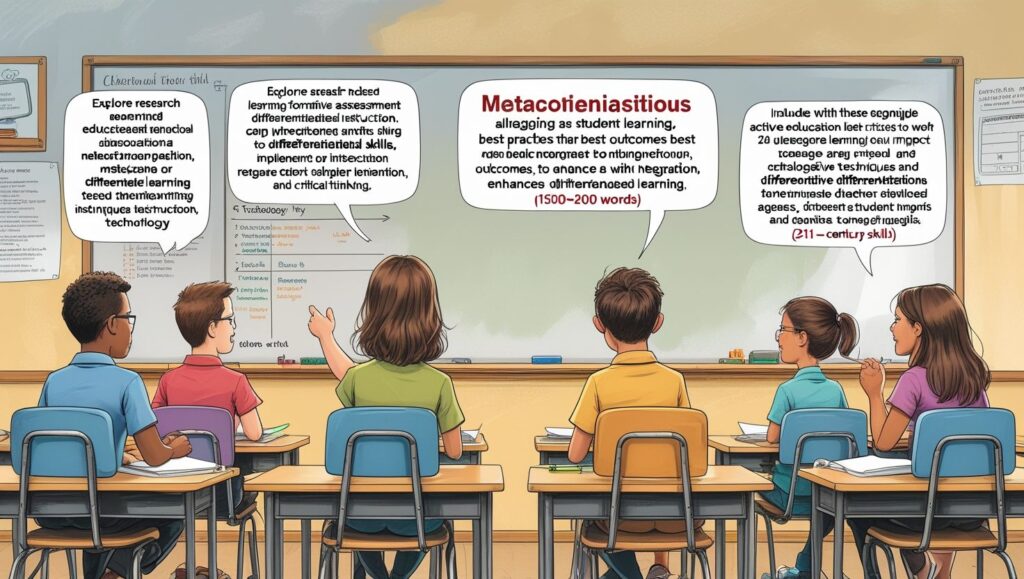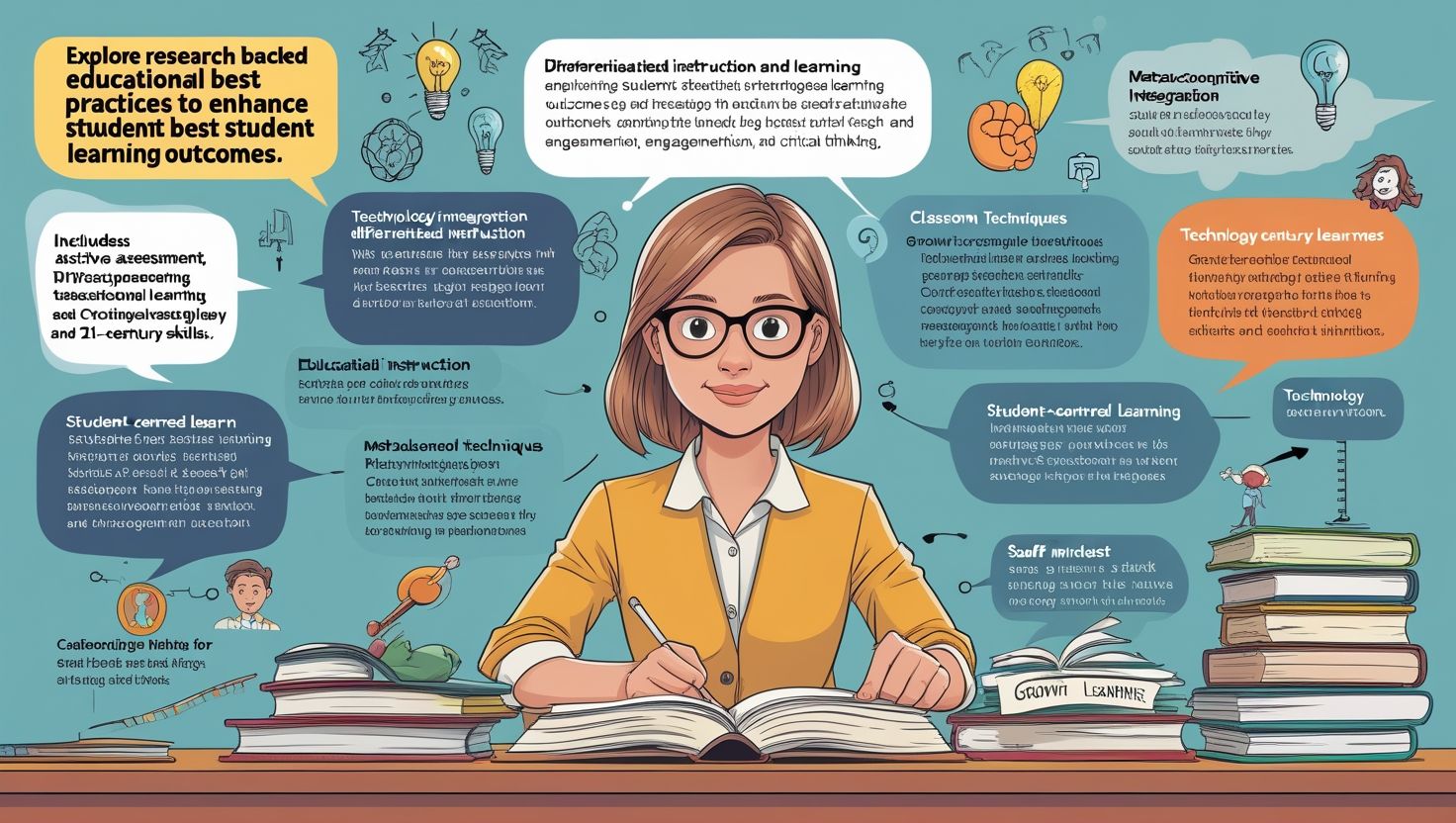Abstract
Educational Best Practices for Learning, Educational best practices refer to instructional strategies, classroom management techniques, and assessment methods that are supported by research and have been shown to result in improved student learning outcomes. These practices are grounded in pedagogical theory, empirical research, and successful classroom applications. This article explores the core dimensions of best practices in education, including learner-centered instruction, differentiated teaching, formative assessment, effective classroom management, and the integration of technology. It also examines the importance of culturally responsive pedagogy, collaborative learning, and continuous professional development. Through a comprehensive review of educational literature and global teaching standards, this article underscores how best practices contribute to equity, engagement, and excellence in education.
1. Introduction
The field of education has undergone significant transformation over the past few decades, propelled by research, technological advancements, and a growing understanding of how students learn. Amidst this evolution, the concept of “best practices” in education has emerged as a crucial guide for educators seeking to improve teaching efficacy and student outcomes. Best practices are not static; they are dynamic strategies refined through continuous evaluation, feedback, and adaptation to diverse learning contexts.
Best practices are not one-size-fits-all approaches but frameworks grounded in evidence and adapted for different educational settings. These practices aim to address the needs of all learners while fostering critical thinking, creativity, and lifelong learning. They are closely aligned with educational objectives at the local, national, and international levels.
2. Learner-Centered Instruction
At the heart of educational best practices is the learner-centered approach, which positions students as active participants in their own learning. This philosophy emphasizes autonomy, critical thinking, and engagement over rote memorization and passive learning.
Key Features:
- Personalization of learning experiences based on students’ interests and needs.
- Encouragement of student voice and choice.
- Active learning strategies such as project-based learning, inquiry-based learning, and experiential learning.
Research by Cornelius-White (2007) supports the notion that learner-centered education increases motivation, self-efficacy, and academic achievement. Educators who practice learner-centered instruction often use real-world applications and problem-solving activities that promote deep understanding.
3. Differentiated Instruction
Diversity in classrooms necessitates differentiated instruction, a best practice that tailors teaching methods and materials to accommodate the varied learning styles, abilities, and backgrounds of students.
Strategies Include:
- Varying content, process, product, and learning environment.
- Using assessment data to inform instructional decisions.
- Grouping students flexibly based on readiness, interest, or learning profile.
Tomlinson (2014), a leading proponent of differentiation, argues that equitable education must account for learner differences, offering multiple paths to knowledge acquisition. This practice is especially important in inclusive classrooms where students with special needs learn alongside their peers.

4. Formative Assessment and Feedback
Effective assessment is not limited to final grades but includes ongoing formative assessments that inform both teaching and learning. These assessments guide instruction and help students identify their strengths and areas for improvement.
Effective Practices:
- Frequent low-stakes quizzes, think-pair-share, exit tickets, and peer reviews.
- Immediate, specific, and constructive feedback.
- Use of rubrics to clarify expectations.
According to Black and Wiliam (1998), formative assessment significantly enhances student achievement, especially when students are actively involved in the feedback process. Transparent and timely feedback promotes a growth mindset and continuous learning.
5. Classroom Management and Positive Discipline
Classroom management is integral to creating a learning environment that is respectful, productive, and conducive to academic success. Best practices in classroom management balance structure with empathy.
Best Practice Elements:
- Establishing clear rules and consistent routines.
- Fostering a safe and supportive atmosphere.
- Implementing restorative practices and conflict resolution strategies.
Effective classroom management minimizes disruptions and maximizes instructional time. Studies show that positive relationships between teachers and students contribute to fewer behavioral problems and greater student engagement (Marzano & Marzano, 2003).

6. Technology Integration
The digital age has transformed educational practices. Technology integration is a best practice when used to enhance, rather than replace, sound pedagogy.
Approaches:
- Blended learning models combining in-person and online instruction.
- Use of digital tools for collaboration, such as Google Workspace or Microsoft Teams.
- Educational apps and platforms that personalize learning (e.g., Khan Academy, Quizlet, Edmodo).
Mishra and Koehler’s (2006) TPACK framework (Technological Pedagogical Content Knowledge) emphasizes the importance of aligning technology with content and pedagogy. When used appropriately, technology expands access, fosters creativity, and supports differentiated instruction.
7. Culturally Responsive Teaching
In an increasingly globalized world, culturally responsive teaching is a key best practice that acknowledges and values students’ cultural backgrounds.
Key Principles:
- Integrating multicultural content and perspectives.
- Using cultural knowledge to inform instruction.
- Promoting respect, equity, and inclusion.
Geneva Gay (2010) defines culturally responsive teaching as using students’ cultural experiences in all aspects of learning. This approach builds trust, increases student engagement, and contributes to a more just and inclusive educational environment.
8. Collaborative Learning
Collaborative or cooperative learning strategies encourage students to work together toward shared academic goals. This practice builds communication, teamwork, and problem-solving skills.
Strategies Include:
- Group projects.
- Peer teaching.
- Socratic seminars and literature circles.
Johnson and Johnson (1999) found that cooperative learning improves academic outcomes and social skills. Group learning prepares students for real-world collaboration and promotes accountability among peers.
9. Professional Development and Reflective Practice
For educators to implement best practices effectively, continuous professional development is essential. Best practices evolve, and so must teachers.
Professional Learning Opportunities:
- Workshops, conferences, and webinars.
- Peer coaching and professional learning communities (PLCs).
- Action research and reflective journaling.
Darling-Hammond et al. (2017) emphasize that sustained, collaborative, and content-focused professional development leads to improved teaching and learning. Teachers must also engage in reflective practice to evaluate and refine their instructional approaches.
10. Evidence-Based Curriculum Design
Curriculum design must reflect the goals of education and be informed by the latest research in cognitive science and pedagogy.
Best Practice Elements:
- Clear learning objectives aligned with standards.
- Spiraling content that revisits key concepts with increasing complexity.
- Cross-disciplinary connections and real-world applications.
Wiggins and McTighe’s (2005) Understanding by Design (UbD) framework advocates backward planning, starting with desired outcomes and designing instruction accordingly. Effective curricula are coherent, balanced, and responsive to student needs.
11. Inclusive Education Practices
Best practices in education uphold the principle that all students, regardless of ability or background, deserve equitable learning opportunities.
Key Approaches:
- Universal Design for Learning (UDL) to provide multiple means of representation, expression, and engagement.
- Collaboration with special education staff and support services.
- Individualized Education Programs (IEPs) and 504 Plans.
Research supports inclusive education as beneficial for all students, not just those with special needs. It fosters empathy, reduces stigma, and improves academic performance for all learners (Florian & Black-Hawkins, 2011).
12. Holistic Development and Social-Emotional Learning (SEL)
Best practices in education go beyond academics to address the emotional and social well-being of students.
SEL Strategies:
- Teaching self-awareness, empathy, and emotional regulation.
- Morning meetings and mindfulness practices.
- Integrating SEL across the curriculum.
According to the Collaborative for Academic, Social, and Emotional Learning (CASEL), students with strong SEL competencies perform better academically and have improved attitudes toward school. SEL contributes to a positive school climate and lifelong success.
13. Parent and Community Engagement
Educational best practices extend beyond the classroom to include families and communities as essential partners in the learning process.
Engagement Practices:
- Regular communication through conferences, newsletters, and digital platforms.
- Involvement in decision-making processes.
- Community-based projects and service learning.
Epstein’s (2001) framework identifies six types of involvement that improve student achievement and school effectiveness. Strong school-community ties enhance relevance, accountability, and support systems for learners.
14. Conclusion
Educational best practices are grounded in research and reflect the complexity of teaching and learning. They emphasize student-centered, inclusive, and adaptive approaches that honor diversity, promote equity, and support lifelong learning. As education continues to evolve in the 21st century, these best practices provide a foundation for reflective teaching, policy development, and systemic reform.
By fostering continuous improvement, collaboration, and innovation, educational best practices are vital in preparing learners to thrive in an increasingly interconnected and dynamic world.
References
- Black, P., & Wiliam, D. (1998). Inside the Black Box: Raising Standards Through Classroom Assessment. Phi Delta Kappan.
- Cornelius-White, J. (2007). Learner-Centered Teacher-Student Relationships Are Effective: A Meta-Analysis. Review of Educational Research, 77(1), 113–143.
- Gay, G. (2010). Culturally Responsive Teaching: Theory, Research, and Practice. Teachers College Press.
- Johnson, D. W., & Johnson, R. T. (1999). Learning Together and Alone: Cooperative, Competitive, and Individualistic Learning. Allyn & Bacon.
- Tomlinson, C. A. (2014). The Differentiated Classroom: Responding to the Needs of All Learners (2nd ed.). ASCD.
- Wiggins, G., & McTighe, J. (2005). Understanding by Design. ASCD.
- Mishra, P., & Koehler, M. J. (2006). Technological Pedagogical Content Knowledge: A Framework for Teacher Knowledge. Teachers College Record, 108(6), 1017–1054.
- Darling-Hammond, L., Hyler, M. E., & Gardner, M. (2017). Effective Teacher Professional Development. Learning Policy Institute.
- Florian, L., & Black-Hawkins, K. (2011). Exploring Inclusive Pedagogy. British Educational Research Journal, 37(5), 813–828.
- Epstein, J. L. (2001). School, Family, and Community Partnerships: Preparing Educators and Improving Schools. Westview Press.

4 thoughts on “Educational Best Practices for Effective Learning”